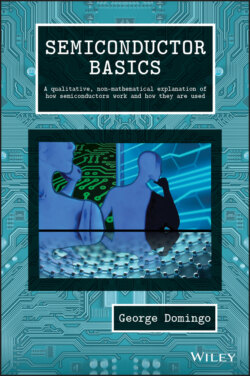Читать книгу Semiconductor Basics - George Domingo - Страница 18
1.6 Light is a Particle
ОглавлениеAlbert Einstein (1879–1955, Figure 1.8) published a paper in 1905 on the theory of the photoelectric effect. When light strikes a metal surface, it frees an electron if its energy is higher than a given threshold value. Any remaining energy is used to kick the electron off the surface. In his paper, Einstein proposed the concept that light has a dual personality; it behaves like a wave or like a particle, and the particle has an energy associated with the wavelength of that light.
He called this particle a “light quantum.” (In 1926, a French physicist named Frithiof Wolfers [1891–1971] renamed the light quantum a photon. It is interesting that Einstein received the Nobel Prize in 1921 for the discovery of the photon, not for his much more famous work on relativity.) This light particle, the photon, has an energy that depends on the frequency of the light. The energy associated with this light is given by the formula
(1.5)
where h is Planck's constant (h = 6.63 10−34 m2 kg s−1), c is the speed of light (c = 3 × 108 m s−1), and λ is the wavelength (m). The meter in the numerator cancels the one in the denominator, resulting in the energy given in Joules (= kg m2 s−2).
Figure 1.8 Around 1905, Albert Einstein came up with the concept that light behaves as both a wave and a particle.
Source: Wikipedia, https://en.wikipedia.org/wiki/Albert_Einstein#/media/File:Einstein_patentoffice.jpg.
